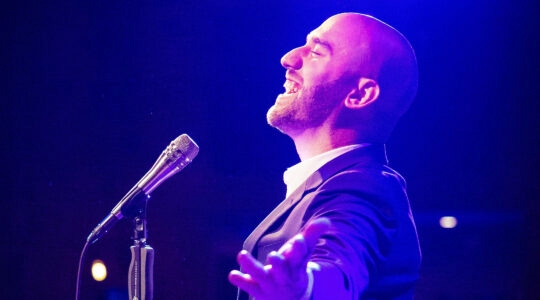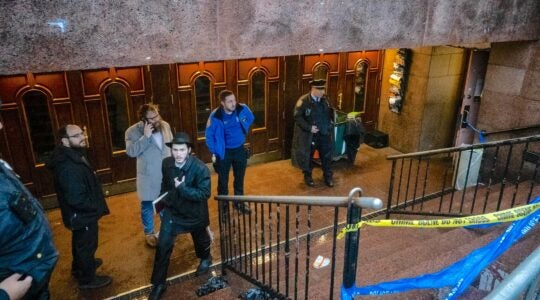Gone are the days when summer camp was the scruffy younger sibling of the Jewish communal world.
Today, while many Jewish institutions, like day schools and synagogues, are recession-battered and scaling back, the Jewish camp movement is relatively flush and poised to expand.
With five new camps it helped "incubate" set to open this summer and backing from powerhouse philanthropists like Mem Bernstein and the Jim Joseph Foundation, the 12-year-old Foundation for Jewish Camp – which represents about 150 nonprofit Jewish overnight camps – is focusing on not simply staying stable but on ambitious growth.
At the group’s biennial Leaders Assembly a few weeks ago, FJC leaders urged camps not to be content with full enrollment and waiting lists, but instead to reach out and strive to bring in "One More Kid," a motto repeated throughout the conference.
"We need to think about how to expand capacity," FJC Chairman Skip Vichness told the approximately 450 camp directors, staff and lay leaders at the opening plenary.
In a sign of the camping world’s heightened stature in the Jewish community the conference was held at a business-class hotel in Jersey City, N.J., and attended by numerous federation, foundation and other philanthropic leaders. Whereas a decade ago, T-shirt clad camp directors shared a conference at a shabby hotel in the Catskills with other members of the now defunct North American Association for Jewish Youth Professionals, they now came attired in business clothes and enjoyed a pre-dinner cocktail hour with wine, beer, an array of appetizers and kosher sushi.
In an interview with The Jewish Week, FJC Chief Operating Officer Maggie Bar-Tura said it is important for Jewish camps to understand that in today’s market a certain "volume of size" is necessary.
"The same way individual jewelry stores are struggling to compete with Kay Jewelers and Zales, and grocery stores are being knocked out by Wal-Mart, mom-and-pop camps are not able to survive today," she said.
In addition, she said, there is a "moral imperative" to reach more children.
"If a camp agrees with us that what they do is incredibly important to the future of children and the community, then they can’t be satisfied until we’re serving every single kid – until every Jewish kid has the opportunity to attend camp in a way that is appropriate for him or her."
According to Bar-Tura, only 10 percent of eligible American Jewish children attend Jewish overnight summer camps, and they represent American Jewry’s wealthiest and most highly affiliated. According to FJC research, 35 percent of children attending Jewish camp come from families making over $200,000 per year, while another 35 percent come from families making between $100,000 and $200,000.
Seeing camp as one of the best ways to engage large numbers of unaffiliated Jews, the FJC is pushing to broaden the camper base.
But amid the pressure to expand, some veteran camp directors are worrying about getting too big too fast and being forced to compromise on quality.
At one conference session entitled "Achieve Big Camp Enrollment While Maintaining That Small Camp Feel," several camp directors expressed reservations about growing too fast.
"I’m not convinced I want to grow bigger," said Bobby Harris, director of the Union for Reform Judaism’s Camp Coleman, which is in Georgia and enrolls approximately 400 campers per session.
"There’s money out there to grow and people who want us to grow," he said, but added that "let’s admit it, it’s harder when you’re bigger to assure that quality."
He said he was pleased that the Reform movement, together with the FJC, is launching Six Points, a Jewish sports camp in nearby Greensboro, N.C., in part because the new camp removes some of the pressure for Camp Coleman to add more kids.
In an interview with The Jewish Week, Harris, whose camp doubled in size in the late 1990s, noted that expanding existing camps is not as simple as "adding another cabin."
"When you start expanding, you get into things like septic systems, permits, will you have to eat in shifts in the dining hall, access to sports fields and finding enough quality staff," he said. "It has to be done in a thoughtful and planful way."
While "we want to give that [camp] experience to as many kids as possible and want them to be able to come back year after year, to do that they have to feel like there’s quality there, that it was a meaningful experience for them," he said. "We all need to make sure to never lose sight of looking at camp through the individual camper’s eyes."
Echoing the "bigger is not always better" mentality, Jonah Geller, the executive director of Tamarack Camps in Michigan, noted at the session that his camp’s decrease from 1,800 kids (spread out over two sessions) in 2000 to 1,250 in recent years was "the best thing that ever happened to us."
"Our numbers were quite good in terms of quantity, but so much feedback I received early on was that we were not doing so well in quality of program," he told The Jewish Week. "It quickly became evident to me that we were trying to serve too many campers."
At the session, several directors talked about the difficulty of tracking where every camper is, of ensuring access to programs and facilities and of being able to respond to parents’ requests when camp gets too large. One large New Jersey Y camp, Cedar Lake Camp, has even begun using a bar-code system to track campers.
Still relatively large, Tamarack has pursued various strategies to ensure campers get individual attention and that counselor morale is high: limiting "all-camp" activities and field trips and instead offering most programs on a unit or age level. The camp, which has greatly increased the number of Jewish counselors, and has improved its return rates of both counselors and campers, also hired staff members whose sole duty is to serve as parent liaisons, responding to parent phone calls and inquiries.
Like Geller, Jon Shapiro, director of Capital Camps, which enrolls approximately 375 campers per session, advised those running large camps to avoid most full-camp activities (including all-camp reunions) and, whenever possible, to reach out individually to each camper and parent.
Although it is "very time consuming," Shapiro said his staff phones each camper during the school year on his or her birthday, a practice that adds a personal touch and is "a great opportunity to get feedback."
The FJC is currently working with eight camps to expand their capacity.
At the same time, it seeks to broaden the market of potential campers. Partnering with Jewish federations, national organizations and private funders, the FJC has in the past four years brought in 10,000 new children through "incentive" scholarships for first-time campers.
The five "incubator" camps opening this summer are all specialty camps, designed to appeal to kids who want to pursue special interests like sports and the environment and who might not otherwise consider a Jewish camp. And a Jewish arts camp is in the talking stages.
The FJC is also working with the Jewish Outreach Institute to train camps to be more welcoming to interfaith and unaffiliated families, and is working with other partners on reaching out to Russian-speaking Jews. And it is currently researching ways of offering lower-cost Jewish summer camps. While financial aid is often available, many Jewish camps cost more than $1,000 per week.
"We’re looking at a community that’s diverse and varied along a bunch of different axes," Bar-Tura said. "You can have upscale Jewish camps that have waterskiing and horseback riding, but can also have Jewish camps in the middle: the same way there is Banana Republic and the Gap and Old Navy."
The New York Jewish Week brings you the stories behind the headlines, keeping you connected to Jewish life in New York. Help sustain the reporting you trust by donating today.




